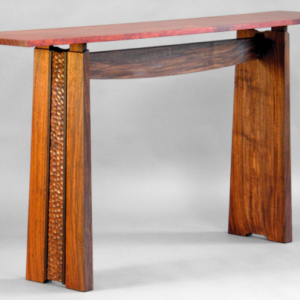I want to make a version of the sofa table in the attached photo. I know, it’s Thomas Troops’s design, but I’m making it for me, not to sell. If I didn’t have inspirational photos to copy, I wouldn’t be able to make anything more interesting than a cutting board.
I have two questions. First, how to attach the trestle to the legs? Sliding dovetail? Or is there another, better solution?
Second question is about attaching the top and overall stability. The trestle is the only thing providing lateral (racking) stability. The trestle is pretty high up and not very wide. Is this enough for the table to be stable? All I can think of to help is to add some corner brackets on the inside of the legs to attach the top. I want the solution to be subtle, so no through tenons. My plan would be to use small brackets and paint them brown to hide them. Any advice on these issues would be greatly appreciated.
Thanks in advance for your help.
John
















Replies
The thing looks high and tippy to me. Probably fine until you put something on it....but to answer your question maybe consider figure 8 fasteners instead of corner rackets.
why not mortice and tenons for both the stretcher and for the leg/top connection? As far as stability, the legs seem as wide as the top, or nearly so, so it looks pretty good to me. It's a decorative table, not a dining table after all.
Thanks for the two comments so far. I'm using a reclaimed table top for the wood. It's right at 7/8" thick, before I strip off the varnish and sand it. I thought about the mortice and tenons but thought the wood was not thick enough, especially since I don't want to do the through tenons.
Would tenons 5/8" long be steady enough to make it stable?
Sure, not a dining table. For me I see anything you call furniture as functional and then decorative. That is with few exceptions ,artiture maybe -- looks kind of like furniture but is clearly a sculpture and wouldn't really function as furniture. A table like that will have things on it,like a bowl of fruit maybe and that will change the center of gravity.
It's like the chests of drawers that when the drawers get filled and then opened the whole thing tips and crushes the kid! Ikea built a whole line of furniture and didn't see that one coming! It just appears narrow and tall to me in the picture. I'd make a mock up of a design like that and test it out before I'd build it.
Anyway, tenons would probably be deep enough glued in to hold but what about wood movement ? I don't see any accounting for that in that design. But then I don't really see how the top is attached from that photo.
Not to be concerned by wood movement, all the wood grain moves in the same direction.
5/8" tenons would have enough strength to hold the top on IMO. Trouble is, it will likely be picked up by the short ends throughout its life. A few screws at a steep angle through the tenons and into the long grain of the top would add some mechanical security and be well out of sight. Think a really steep angle like how pocket screw is driven.
Making the top of each leg a twin tenon would double your glue surfaces. The effective glue surfaces are running parallel to the long edge of the table.
A short stretcher below & between the tenons of each leg unit could accept screws to hold the top down as well.
+1 with Gulfstar (with a capital G) on wood movement being a non-issue.
Fasten it to the wall, or find another design............
This forum post is now archived. Commenting has been disabled